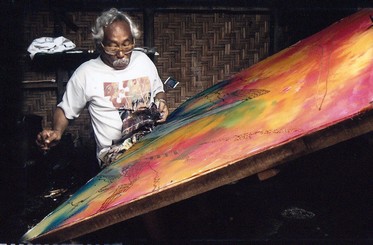Batik is a form of fabric art where melted wax or malam, is applied to cloth before dipped in dye. This art is associated closely with the Malay people. Yet, many are not aware that batik has a very universal appeal and is an established art form in China, Japan and India. The Malays have used batik in their own unique ways. The renowned batik extraordinaire Sarkasi himself puts it, “A Malay uses batik from the time of his birth to the time of his funeral.” Different types of batik have their individual stories and purpose. In Indonesia, the Batik Larangan (Forbidden Batik) is still the exclusive domain of the Javanese royal house.
Assetton is proud to introduce the works of the Baron of Batik, Sarkasi Said.
Sarkasi’s artistry, spanning more than 4 decades, have toured Singapore, Malaysia, Thailand, New Zealand, USA, Japan and France. They have also found their way into many distinguished public and private collections including the National Museum of Singapore, Her Royal Highness Sultana of Johore, Her Royal Highness Pengiran Hajjah Mariam Brunei Darussalam, the Singapore High Commission in Brunei, Kuala Lumpur and the President of the Republic of Singapore.
His accolades are numerous. In 1974, he won the Pingat APAD, from Angkatan Pelukis Aneka Daya or APAD, a local art group for his contributions to the development of art. This was followed by a string of other awards, including: Best Foreign Entry Sarasota Art Society (USA) in 1981, the First Prize -Abstract Category for The 8th UOB Painting of the Year Award in1989, and Highest Commendations in the IBM Art Award in 1990. More recently, he holds a record in the Guinness Book of Records of having painted the world’s longest Batik painting of 103.9 metres.
Mr Said has also contributed to numerous charitable events. Throughout his eminent art career, Sarkasi has held numerous exhibitions to showcase his works in countries including Singapore, New Zealand, Indonesia, Japan, Malaysia and the United States.
The idyllic kampongs and the Botanic Gardens became Sarkasi’s workshop where he developed his distinctive style that is closely linked with the world of nature. With graceful brush strokes, Sarkasi effortlessly captures on canvas the beauty and wonders of this world with a celebration of exuberant and lively colours, developing a pictorial language that is both distinctive and compelling. It is a vision in which nature and artifice are entwined and which appears to promise images symbolising continuous metamorphosis.
Sarkasi employs colour in order to convey splendour and radiance. And he does so with the full confidence in the capacity of colour to invoke optimism, vivacity and energy. His artistry is firmly rooted in the conviction that art and nature are connected and are mutually inter-reliant.
Assetton is offering a limited number of original Sarkasi Said works of art. Each piece is an original work of art. The 5 themes are: Mother & Child, Floral, Kampung, Abstract and Urban Landscape. No limited editions, prints, lithographs, etc.

